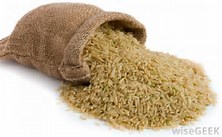
Arsenic in Rice
What is arsenic?
Arsenic is an element in the Earth’s crust, and is present in water, air, and soil. It occurs both naturally in the environment and as a result of human activity, including from erosion of arsenic-containing rocks, volcanic eruptions, contamination from mining and smelting ores and previous or current use of arsenic-containing pesticides.
Are there different types of arsenic?
There are two general types of arsenic: organic and inorganic (these together are referred to as “total arsenic”). The term “organic” in this context has nothing to do with types of farming; it refers to chemical elements. If arsenic atoms bond with carbon, the compound is organic. If there’s no carbon present, it’s inorganic. Of the two types, the inorganic forms of arsenic have been more closely associated with adverse health effects.
What about arsenic in rice?
Rice, a staple of the global diet, is a leading dietary source of inorganic arsenic, both because of how commonly it’s consumed and because as rice plants grow, the plant and grain tend to absorb arsenic more readily than other food crops.
Do organic foods have less arsenic than non-organic foods?
Because arsenic is naturally found in the soil and water, it is absorbed by plants regardless of whether they are grown under conventional or organic farming practices. The FDA is unaware of any data that show a difference in the amount of arsenic found in organic rice versus conventionally grown rice.
What are the health risks associated with arsenic exposure?
Long-term exposure to high levels of arsenic is associated with higher rates of skin, bladder and lung cancers, as well as heart disease. The FDA is currently examining these and other long-term effects.
What the FDA Is Doing About Arsenic in Rice
Why did the FDA choose to focus on arsenic in rice?
Preliminary data that have now been confirmed indicated that rice had higher levels of inorganic arsenic than other foods, in part because as rice plants grow, the plant and grain tend to absorb arsenic more readily than other food crops. Rice is a staple in the U.S. diet and is widely consumed, including by infants. Additionally, rice intake, primarily through infant rice cereal, is about three times greater for infants than adults in relation to body weight.
What has the FDA done about arsenic in rice?
Based on its testing, the FDA on April 1, 2016 proposed an action level, or limit, of 100 parts per billion (ppb) for inorganic arsenic in infant rice cereal. This level, which is based on the FDA’s assessment of a large body of scientific information, seeks to reduce infant exposure to inorganic arsenic.
The FDA found that inorganic arsenic exposure in infants and pregnant women can result in a child’s decreased performance on certain developmental tests that measure learning, based on epidemiological evidence about arsenic, including dietary exposures.
Advice for Consumers
What is FDA recommending to consumers about eating rice and rice products?
Based on the currently available data and scientific literature, the FDA’s advice for consumers, including pregnant women, is to eat a well-balanced diet for good nutrition and to minimize potential adverse consequences from consuming an excess of any one food. Additionally, parents should follow the advice of the American Academy of Pediatrics and feed their infants and toddlers a variety of grains as part of a well-balanced diet.
Based on the FDA’s findings with respect to inorganic arsenic in rice, the agency offers the following advice to parents and caregivers of infants.
- Feed your baby iron-fortified cereals to be sure she or he is receiving enough of this important nutrient.
- Rice cereal fortified with iron is a good source of nutrients for your baby, but it shouldn’t be the only source, and does not need to be the first source. Other fortified infant cereals include oat, barley and multigrain.
- For toddlers, provide a well-balanced diet, which includes a variety of grains.
Is it ok for me to eat rice and give it to my children?
Consumers can certainly eat rice as part of a well-balanced diet. Based on the FDA’s scientific assessment, it is recommended that parents and caregivers feed their infants a variety of fortified infant cereals, rather than to rely solely on infant rice cereal. We also encourage pregnant women to eat a variety of foods, including varied grains.
Can the consumer do anything to offset or reduce the arsenic in rice?
Published studies, including research by the FDA, indicate that cooking rice in excess water (from six to 10 parts water to one part rice), and draining the excess water, can reduce 40 to 60 percent of the inorganic arsenic content, depending on the type of rice.
The FDA recognizes that consumers do not typically prepare rice in this manner, similar to preparing pasta, and some may not wish to do so.
The new FDA research also shows that rinsing rice before cooking has a minimal effect on the arsenic content of the cooked grain. Rinsing does, however, wash off iron, folate, thiamin and niacin from polished and parboiled rice. The tables below provide additional information on the study’s findings.
Percent reduction with rinsing
| Rice | Inorganic Arsenic | ||||
| Brown | 0 | ||||
| Polished (White) | 16 | ||||
| Parboiled | 9 |
Percent reduction with cooking in excess water (averaged 6:1 and 10:1 ratios)
| Rice | Inorganic Arsenic | ||||
| Brown | 50 | ||||
| Polished (White) | 43 | ||||
| Parboiled | 61 |
Dr. Greger’s Extensive Investigation of Arsenic in Rice and Other Foods
Dr. Michael Greger has produced a number of videos on food sources containing inorganic arsenic. These videos include recommendations on how we can limit our exposure to dietary arsenic. You can access links to a series of videos by clicking here.
According to Dr. Greger, brown basmati rice from California, India or Pakistan contain much lower amounts of arsenic compared to brown rice grown in Arkansas or Texas.
Brown rice can be a part of a well balanced WFPB diet, but it looks like we should make an effort to include brown rice as part of a variety of grains in our diet.
Many folks on gluten-free diets tend to eat a lot of rice. If this describes you, you may want to replace some of that rice with other gluten-free grains.
If you’d like to learn about which types and brands of rice are lowest in arsenic, click here for a great Dr. Greger video.
Stay Healthy and Strong!






 E Excerpt from Laurie Endicott Thomas’s amazing book Thin Diabetes – Fat Diabetes by clicking here!
E Excerpt from Laurie Endicott Thomas’s amazing book Thin Diabetes – Fat Diabetes by clicking here!
Thank you for the great information! Variety in our diet is key!